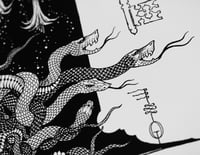Necrophania – art print, Din A3
Hypnos and Thanatos, Sleep and Death are two siblings that resemble each other at first glance, yet they impersonate two different human states. Both are inevitable, we can't prevent neither from falling asleep, nor from dying. Our conscious mind shuts off without us being able to anything against it, every action that is tied to our physical self is escaping our control and we are in a transcendental state that we can't grasp any longer as soon as we leave it. Just as humans don't remember most of their dreams after they wake up, we can't remember our past lives after being reborn – a belief that is common in both Western and Eastern philosophy. For Plato dying is the process of the eternal soul leaving its mortal shell to rise up to the heavens (the Platonic realm of ideas) where it's waiting to inhabit a new body. Once the soul returns to the earth the person inhabiting it loses access to the experiences and the knowledge the soul had before being caught into this mortal shell. The process of sleeping, dreaming and waking up again is very similar to this Platonic theory and the reason why we call “Sleep” the little brother of “Death”. There are few states though, where the line between Hypnos and Thanatos is starting to blur. Near-death-experiences or being in a coma are two of these exceptions where one can pass the threshold of sleep and death in both directions. The illustration “Necrophania” shows elements that can denote both sleep and death: The poison of the snake as well as the poison of the Brugmansia can both heal and ease from pain, but also end an earthly existence. The woman of which is uncertain if she's sleeping or dead, is lying between those symbols and is flanked by a keyhole with the matching key on the other side – a symbol of closing and/or opening a door and thus closing an old or opening a new chapter.
42 x 29,7 cm. Printed on Hahnemühle textured FineArt archival paper (210 gsm).
Worldwide tracked shipping.
Thank you for stopping by!











